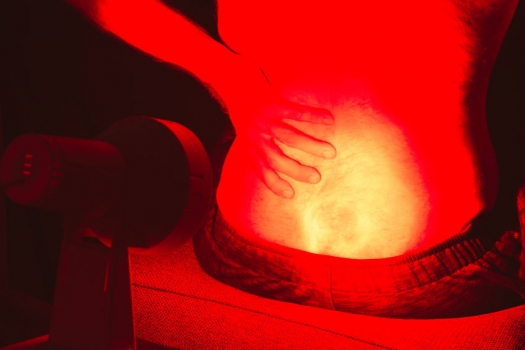InfraredLightLampTherapy.jpg

Photo by Jaroslav Moravcik / 123rf.com
We get so caught up in the material world that we often forget our body is actually mostly energy. Without getting too quantum on you, it’s important to remember that the physical part of you is only a small part of who you actually are.
Our bodies give off energy and we are affected by energy – but it’s so easy to forget because we can’t see it. This concept is also somewhat tricky to understand. It’s why some people are sensitive to EMF that’s put off by Wi-Fi devices, and how electroencephalography (EEG) scans of the the brain can measure energy emitted.
We are creatures that evolved to live in light. These days we spent about 90% of our time indoors and as a result have significantly reduced the amount of exposure we get to various light wavelengths. Also called photobiomodulation, red light therapy provides just the right wavelengths our body uses for rejuvenating processes.
The importance of light wavelengths
Since the invention of the light bulb in 1879 we changed the light landscape completely. For the same reason people often recommend avoiding screens before bedtime, light has the distinct ability to affect our biology.
All light falls on a spectrum. Visible light ranges from 400 nm (close to ultraviolet) and 700 nm close to infrared). When it comes to red light therapy, the range is usually between 600 to 800 nm and often referred to as near infrared or NIR. This can be considered the therapeutic sweet spot of light therapy.
What red light therapy does in the body
People skeptical of light therapy usually have a hard time believing it because we focus so much on the biochemical processes. But just like plants convert light energy into chemical energy with photosynthesis, we have processes in our body that allow us to take near infrared light and turn it into our cellular energy molecule adenosine triphosphate (ATP).
ATP is the energy currency of our body – when you don’t have sufficient ATP processes in your body, you feel it in your own personal energy levels. Your body needs ATP for nearly every single process and without it you would die within seconds – this is actually how the poison cyanide works.
To build ATP, your body uses an enzyme called cytochrome c oxidase, which binds oxygen with nicotinamide adenine dinucleotide (NAD) and hydrogen (H). This takes the molecule NAD and makes it NADH, which produces ATP in the process.
We need sufficient cytochrome c oxidase and NADH to make ATP. If you have too much nitric oxide, it can swoop in and take over cytochrome c oxidase, so it’s not as available to make ATP. Too much nitric oxide can be caused by many things including, stress and illness.
Photobiomodulation stops nitric oxide from using up the cytochrome c oxidase enzyme so it can be available to make ATP.
Pretty cool, right?
This is why red light therapy is so effective, because it gives your body more energy molecules to work with. When your body has more ATP available it can focus on rejuvenating processes that it once had to put on hold. These include repairing your skin, reducing inflammation, and speeding up much needed recovery processes.
11 science-backed red light therapy benefits
When you look at the research behind the benefits of photobiomodulation, a few themes come to light (pun intended). First, you’ll notice that a lot of the benefits have to do with skin and tissue. This could be because when it comes to your survival, repairing the wrinkles on your face is low priority, for example.
Essentially, when you free up ATP in the body with red light therapy, your body has more energy to work with. Scientifically backed benefits of red light therapy include:
- Stimulating the production of collagen and elastin
- Reducing the appearance of fine lines and wrinkles
- Improving the appearance of stretch marks
- Increasing blood circulation
- Evening out skin complexion
- Speeding up workout recovery
- Reducing inflammation
- Reducing joint pain and arthritis symptoms
- Improving athletic performance
- Speeding up wound healing
- Reducing symptoms of skin conditions, such as acne, rosacea, and eczema
Personally, I’ve had a lot of success with red light therapy in people who experience chronic pain or have autoimmune skin conditions. Because red light therapy reduces overall inflammation, especially in the skin, it’s often a treatment that provides a lot of relief to those who have previously suffered with little help from other therapy options. Anyone with eczema or rosacea will tell you how extremely frustrating and painful the condition can be, and red light therapy is a good option for people with these conditions.
Red light therapy at home
Fortunately, because there’s a shift in the world of health to combat daily assaults on our body from our modern lifestyle, we have access to helpful tools and tricks to restore homeostasis in the body. Red light therapies used to only be available in forward thinking doctor’s offices and with other healthcare professionals, but now companies are making high-quality products that you can use in the comfort of your own home.
Joovv is a company that created an LED red light therapy panel you can keep in your bathroom or bedroom. By simply standing in front of Joovv for 5 to 10 minutes a day, you can reap the benefits of red light therapy. Sure, it’s an investment, but the benefit of having it in your home means it’s something you can do every single day. So quickly, these therapeutic sessions add up. Plus, what’s more important than your health? Not to mention, it’s a natural alternative to painkillers and steroid skin creams.
I get excited about companies like Joovv because they are putting power back in the hands of people. They’re creating products that are much better alternatives to getting stuck on the runaway train of pharmaceuticals. That is something worth getting fired up about!
Resources
Berg JM, Tymoczko JL, Stryer L. Biochemistry. 5th edition. New York: W H Freeman; 2002. Chapter 18, Oxidative Phosphorylation.
Ferraresi C, Hamblin MR, Parizotto NA. Low-level laser (light) therapy (LLLT) on muscle tissue: performance, fatigue and repair benefited by the power of light. Photonics Lasers Med. 2012;1(4):267-286.
Al Rashoud, A.S. et al. Efficacy of low-level laser therapy applied at acupuncture points in knee osteoarthritis: a randomised double-blind comparative trial. Physiotherapy, Volume 100, Issue 3, 242-248.
Mitchell UH, Mack GL. Low-level laser treatment with near-infrared light increases venous nitric oxide levels acutely: a single-blind, randomized clinical trial of efficacy. Am J Phys Med Rehabil. 2013 Feb;92(2):151-6.
Chaves ME, Araújo AR, Piancastelli AC, Pinotti M. Effects of low-power light therapy on wound healing: LASER x LED. An Bras Dermatol. 2014;89(4):616-23.
Turn On The Red Light! Red Light Therapy Charges Your Mitochondria, Revitalizes Your Skin, and Reduces Pain originally published on Dr. Jill Carnahan's website, August 16, 2018.


